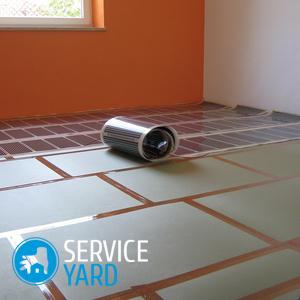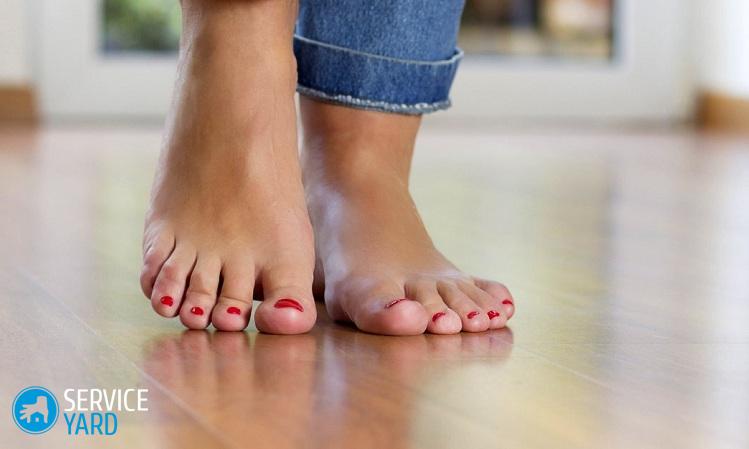Laminate for a warm water floor - which one to choose?

Floor heating systems appear in apartments more and more. It is very convenient. However, those who decide to lay pipes or heaters on the floor will inevitably think about the quality of the finish. Many choose laminated panels, but are they good in this case? Laminate for a warm water floor - which one to choose? This will be discussed in the article.
to contents ↑Warm floor under the laminate - which is better to choose?
Before answering a question, a laminate under a warm floor - how to choose, it is very useful to figure out what kind of floor heating system you want. In modern apartments and private houses, three options are used:
- water;
- electric;
- infrared.
Water heating
Water heated floors work in much the same way as most conventional central heating batteries. Just the pipes are laid horizontally and are not in one corner, but throughout the room. In addition, a coating is laid on top of them.
The advantages of this heating method are obvious:
- with proper installation, the system lasts a long time, because it does not contact the external environment and is not subjected to mechanical stress;
- no risk of fire;
- heating costs remain the same as when using conventional batteries;
- pipes do not spoil the appearance of the room.
If we talk about the cons, then they can include the following:
- installation of such systems is a rather complicated matter, which is better to entrust to professionals;
- it is necessary to do a coupler;
- if an accident occurs, you have to disassemble a fairly large area of the floor;
- relatively high cost of the system and work;
- the need to coordinate the procedure with local authorities and utilities.
to contents ↑Important! Before buying the system itself and the laminate, you need to consult with the utility company serving your house whether this can be done at all - not all houses have the technical ability to radically change heating systems.
Electric
Electric underfloor heating is a system of heating elements connected by wires. The main advantage is that approvals are not needed. But then it is very important to observe the technology during installation.
The advantages of the system are as follows:
- lower cost of the device and installation work compared to water systems;
- the ability to turn on heating when you need it;
- autonomy;
- high efficiency;
- simpler installation.
Such a system also has disadvantages that must be taken into account:
- TENY can overheat and even burn out;
- electrical wiring in the house must be performed very high quality;
- need grounding
- increased electricity costs.
Infrared floor
And yet, what kind of underfloor heating is better under the laminate? If you seriously asked this question, be sure to pay attention to the infrared film. This is also a variant of the electric floor, but more modern. Just the radiation is in the infrared region of the spectrum:
- It is mounted easier than a conventional electric one, since it is a film into which all the elements are already inserted.
- Such a system is still more expensive than others, but you can significantly save on installation, and such a floor does not absorb much energy.
- In addition, there is no danger that the radiating elements may overheat, as there is no risk of a short circuit.
Choose a laminate
Regardless of which system of underfloor heating you prefer, you need to correctly evaluate the possibilities of the finish coating, that is, the laminate itself. You must choose it very carefully.
At its core, a laminate is a plate of pressed sawdust, reinforced and protected by several layers of other materials. With too intense loads and a sharp deviation from the optimal temperature regime, it will behave just like any other plate of pressed sawdust, that is, deform. Any laminate, even very high quality, deteriorates from two things:
- moisture
- sharp temperature difference.
Therefore, when laying a warm floor, two conditions must be carefully observed:
- moisture penetration on the laminate should be completely eliminated;
- temperature conditions must be strictly observed.
Temperature
The warm floor on which the laminate is laid should be just warm, not hot. Its temperature should not exceed 25 ° C. An increase of at least a degree leads to dire consequences:
- The column of the thermometer rises to 26 ° C, and the protective film begins to disintegrate into formaldehydes, which can be extremely harmful to the inhabitants of the apartment.
- The floor heats up another degree, and the stove begins to crumble.
Pick up each other
Electric underfloor heating - how to choose a laminate? You need to pay attention to the same points as when choosing a coating for water floors:
- Be sure to look at the markings on the packaging of the laminate - it should indicate what kind of heating system this material is intended for.
- Heating elements of the electric floor are not necessarily located throughout the room: they are needed most of all where your household is most often located or moved.
- Power of heating elements should not exceed 110 W per square meter.
How to mount an electric floor under a laminate?
Why is laminate flooring the ideal place to use where floor heating systems are used? The fact is that the elements of any systems periodically fail, they have to be repaired or replaced, which means that they should have relatively easy access. The laminate section is much easier to remove than, for example, parquet.
During installation, both technologies must be considered:
- installation of a heating system;
- laying the topcoat.
These technologies have common points:
- a waterproofing layer is laid on the rough base, since both the heating system and the laminate need protection from moisture;
- waterproofing is closed with a heat-insulating layer;
- a substrate is mounted between the heating system and the laminate;
- the soundproofing layer does not fit;
- a gap must be left against the wall.
Waterproofing
The following materials are mainly used as waterproofing:
- polystyrene;
- polyethylene.
Their qualities are approximately the same, the choice is mainly affected by the presence of one and the other at the moment on sale. As for thermal insulation, it has several functions:
- increase system efficiency;
- reduction in energy consumption.
Substrate
Laminate is never laid directly on pipes or wires. First mount the substrate, which performs several tasks:
- surface leveling;
- reduction of mechanical impact on the panel;
- reduction of load on locks;
- thermal film protection.
Important! As a rule, especially durable polystyrene substrates with a corrugated surface are used to lay the laminate on heating systems. Such to the building materials market is supplied, for example, by the Polish company Fix Prix.
Why is sound insulation not needed?
Do you want to provide reliable sound insulation and decided to lay something on the floor that allows you to solve this problem? Stop, when laying a warm floor, this should never be done. An additional substrate with soundproofing properties will no less successfully limit the flow of heat into the room. Since the heat remains in place, the system may overheat and even burn out.
Why gaps and relays?
There are always thermal deformations of surfaces. Some materials are more susceptible to them, while others are less affected. How much these mandatory changes in the parameters will affect the strength of the structure is entirely up to you. If the laminate has room to expand, it will remain unscathed. So the gap between him and the wall is absolutely necessary.
Relay is also a very useful thing. It will not allow the temperature to rise above standard values, which means it will not allow the system to overheat.
Operating procedure
The electrical heating system must be mounted in the following order:
- Level the surface and clean the floor.
- Install heat and water insulation.
- Pour leveling screed with reinforcing mesh.
- Allow to dry.
- Install the heating system.
- Install thermostat and sensor.
- Check operability.
- Pour screed.
- Dry the structure for about a month.
- Lay laminate flooring.
to contents ↑Important! The easiest option for a warm floor is a heating mat, a screed in this case is not required.
A couple of tips for the future:
- Have you made an electric heated floor and laid the laminate? Fine! But, since heaters rarely fit over the entire surface, you probably determined in advance where they would be. And drew a diagram. Save your drawing - it can help you out very much if you suddenly need repair.
- The second important point: if you like rugs, do not lay them where the heating elements are. The surface may overheat, as a result - begin to release harmful substances and decay.
Laminate and water floors
As in the previous case, the substrate is laid on the rough floor. Usually it consists of one or two layers, but it still has two functions:
- energy saving;
- waterproofing.
As a material, polystyrene foam is used. The substrate is made with holes.
Important! The most affordable option is the Polish Arbiton material, but you can find others, including those from the largest manufacturers of underfloor heating.
The water floor warms up less than the electric one, so the laminate is not threatened with spoilage, unless the pipes leak. The operating procedure will be approximately the same as when laying the electric floor, only it is not necessary to check the entire system for operability, and the screed dries much faster.
to contents ↑Infrared floors
To the question of which company is the best infrared underfloor heating under the laminate, you can answer simply - any European or American. You need to focus not so much on the brand, but on the ratio of price and quality.
For a laminate, such a heating system is just perfect. The infrared floor is covered with graphite or bimetal film. No preparatory work is needed - no waterproofing, no screeds. The only thing you need is good electrical wiring. Everything else is included.
The floor consists of four layers:
- heat reflecting substrate;
- infrared film;
- leveling substrate;
- topcoat.
To lay such a floor, you need:
- temperature regulator with sensor;
- screwdrivers;
- pliers;
- scissors;
- knife;
- Scotch.
For the entire installation, it will take you a couple of hours or a little more:
- Calculate the amount of infrared film: if there are other heating devices in the room, it will take about half the area, if there are no such devices, about 80%.
- Cover the floor with water-repellent film.
- Put penofol or isolon.
- In the free zone of the room, lay the thermal film.
- Make penofole cutouts to fix the thermal film.
- Set the leveling backing.
- Lay the laminate flooring.
to contents ↑Important! For infrared underfloor heating, grounding is required.
About laminate quality
The strength of the floor depends not only on the quality of the heating system, but also on the type of laminate. It is better to choose a material of class 33 or 34 - it is usually made with full observance of technology, therefore it is more durable and less prone to deformation. As for the fastener system, it can be any. Most importantly, the heating system and the coating should fit together.
to contents ↑Stock footage
That's all you needed to know in order to choose a laminate for a warm floor and the warm floor itself. We hope that you thought it over several times before you went to the store, correctly made a purchase, and now your house is not only warm, but also safe. And all this - without unnecessary damage to the family budget!
- How to choose a vacuum cleaner taking into account the characteristics of the house and coatings?
- What to look for when choosing a water delivery
- How to quickly create comfort at home - tips for housewives
- How to choose the perfect TV - useful tips
- What to look for when choosing blinds
- What should be running shoes?
- What useful things can you buy in a hardware store
- Iphone 11 pro max review
- Than iPhone is better than Android smartphones






